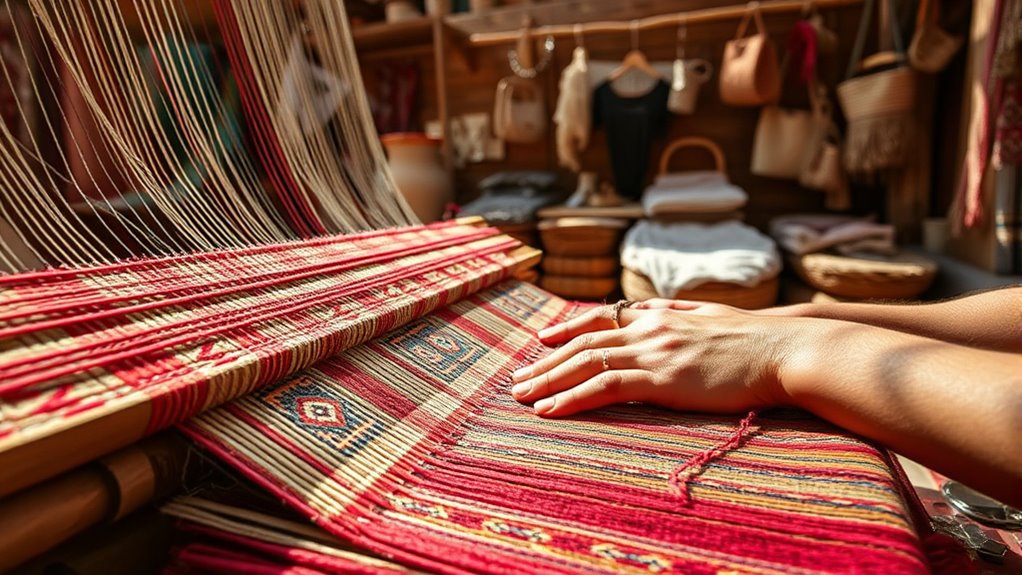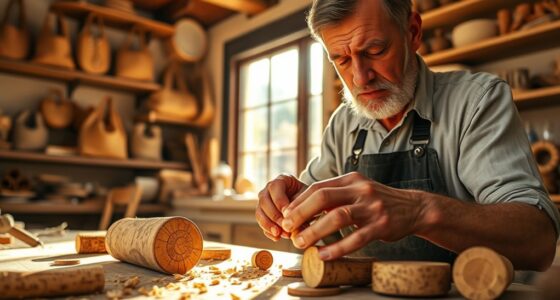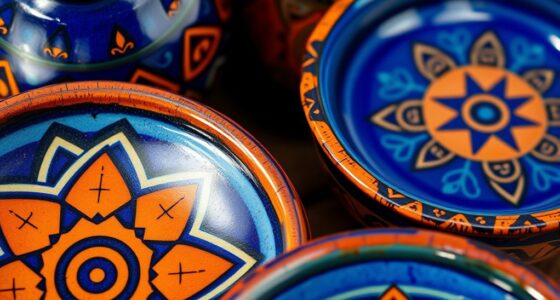Sardinian handicrafts, especially weaving and textiles, showcase a rich history rooted in ancient traditions that date back to pre-Nuragic times. You’ll see regional styles featuring unique techniques, symbolic motifs, and natural fibers like wool, cotton, and linen, often dyed with local plants. Women have traditionally kept these crafts alive, passing down skills through generations. To explore how these vibrant textiles continue to thrive today, keep investigating their cultural significance and modern revival.
Key Takeaways
- Sardinian weaving dates back to ancient times, featuring regional techniques, motifs, and natural dyeing methods.
- Traditional textiles include orbace wool, cotton, and linen, often decorated with symbolic patterns and geometric designs.
- Women historically preserve weaving skills, passing techniques, motifs, and dyes through generations within families.
- Key regions like Samugheo, Nule, and Aggius have distinct styles, motifs, and weaving traditions recognized as cultural heritage.
- Contemporary efforts focus on heritage preservation, artisan workshops, and promoting Sardinian textiles to cultural and tourism markets.
The Historical Roots of Sardinian Weaving
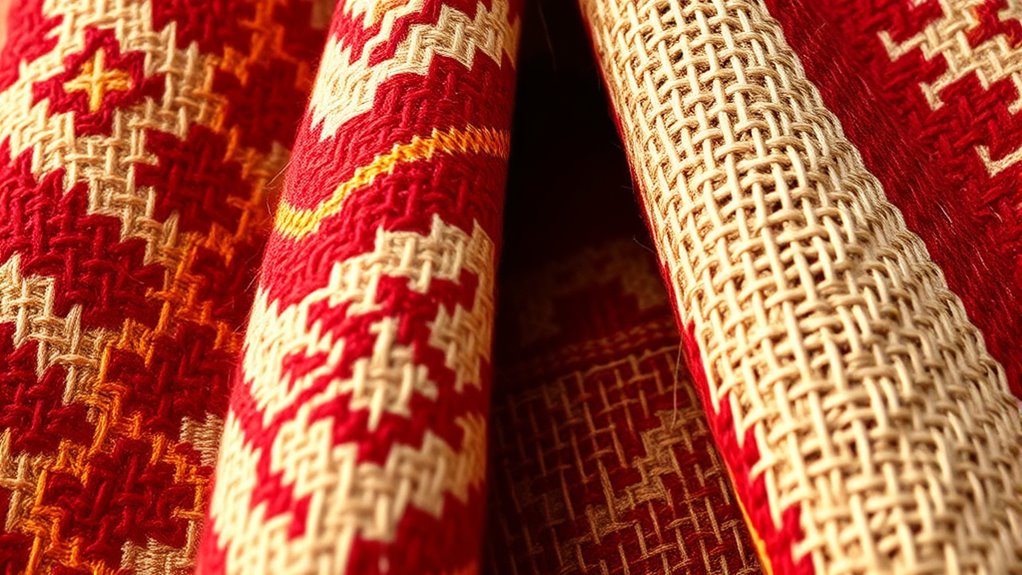
The historical roots of Sardinian weaving run deep, stretching back to ancient times when early Mediterranean cultures influenced local craftsmanship. Even before the Nuragic era, people used looms, showing an early grasp of weaving techniques. Initially, weaving served domestic needs, especially for preparing dowries passed from generation to generation. Over time, different periods shaped its development. The Nuragic era introduced skilled craftsmanship in iron, ceramics, and stone, which influenced weaving. During Roman rule, new materials and techniques appeared, while the Middle Ages brought influences from Vandals and Byzantines. Despite challenges during the Spanish period, weaving persisted mainly for churches and aristocracy. Later, under the Kingdom of Sardinia, artisan shops grew, expanding craftsmanship for the emerging bourgeoisie and embedding weaving into Sardinian culture. Additionally, the integration of traditional textile techniques with modern methods has helped preserve these ancient crafts for future generations.
Traditional Techniques and Craftsmanship
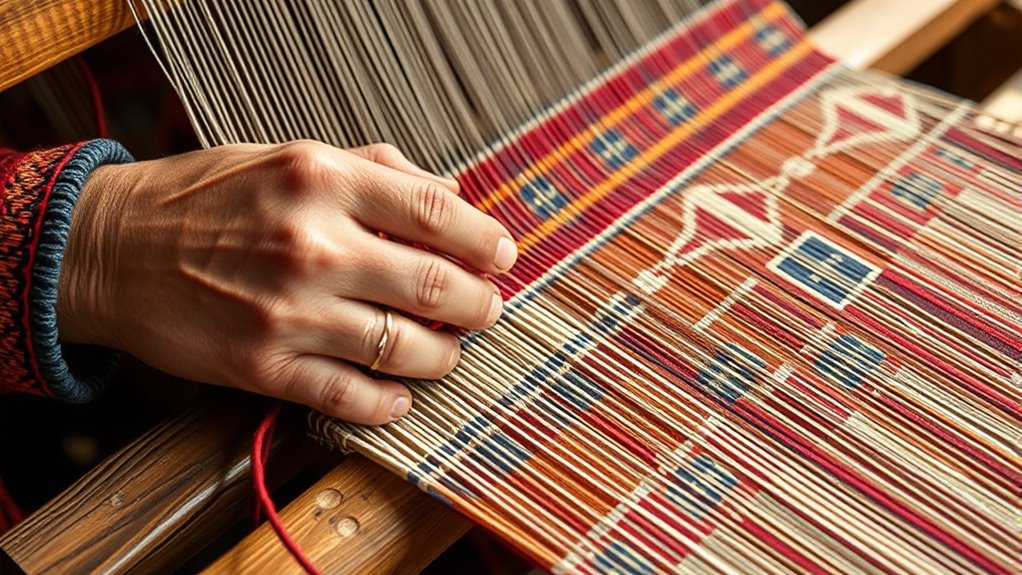
Traditional Sardinian weaving showcases a rich array of techniques that highlight the skill and artistry of local artisans. You’ll find methods like:
- Horizontal looms for pibiones, creating textured patterns with raised bumps.
- Vertical looms used in Nule for geometric carpet designs.
- Twill weave producing diagonal patterns on orbace fabric.
- Warp-faced weave, where warp threads dominate, shaping intricate designs.
You’ll notice how women, historically central to this craft, pass techniques down through generations, maintaining social and cultural importance. Weaving involves complex steps: counting thousands of warp threads, planning patterns meticulously, and selecting fibers like wool or cotton. The precision required in setting up the loom is essential to ensure the accuracy of traditional patterns. Additionally, preserving these techniques is crucial for cultural heritage and sustaining artisanal craftsmanship. This time-consuming process reflects a deep mastery, preserving Sardinia’s artisanal legacy and cultural identity.
Key Materials Used in Sardinian Textiles
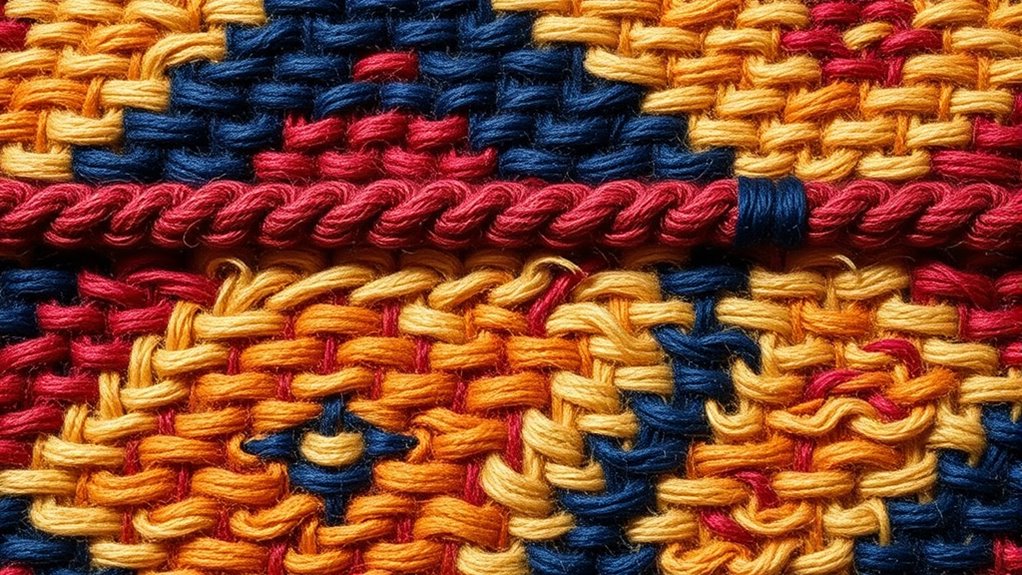
You’ll notice that natural fibers like sheep’s wool, flax, hemp, and cotton form the backbone of Sardinian textiles. These materials are valued for their durability, breathability, and sustainability, reflecting the island’s rich craft heritage. Additionally, traditional vegetable dyes sourced from local plants add vibrant, natural colors to these fabrics. Modern artisans continue to preserve these materials, ensuring the continuation of Sardinian textile traditions. The fiber properties of these materials contribute significantly to the quality and longevity of the textiles.
Natural Fibers Employed
Sardinian textiles showcase a rich diversity of natural fibers, each chosen for its unique properties and contribution to the region’s craftsmanship. You’ll find four main fibers shaping these textiles:
- Orbace wool: Derived from local sheep, it’s waterproof, durable, and resistant after fulling, often woven by hand.
- Cotton: Used mainly for warp threads, offering softness and strength, perfect for intricate patterns.
- Linen: Recognized for its golden color and stiffness, it’s used for decorative motifs and adds longevity.
- Blended fibers: Artisans mix orbace wool with softer fibers like merino, cotton, or linen to enhance texture and durability.
These fibers, naturally colored and carefully selected, define Sardinian textile’s authenticity and timeless appeal. The selection process emphasizes quality and tradition, ensuring each textile reflects Sardinian cultural heritage.
Traditional Dye Sources
Coloring Sardinian textiles relies heavily on natural dye sources derived from local plants, insects, and shrubs. You’ll find onion skins commonly used to produce a warm yellow hue, while saffron offers vibrant, intense yellows prized for their brightness. Daphne gnidium, a native shrub, yields soft yellow shades, and other wild shrubs contribute subtle variations. For black and brown shades, traditional methods involve boiling wool with Daphne gnidium roots or using walnut husks for rich browns. Logwood, introduced centuries ago, provides a deep black, and pomegranate bark creates durable dark tones. Red and scarlet shades come from kermes insects and madder plants, both highly valued. Green tones are achieved with ivy, buckthorn, and myrtle leaves, while purple and lavender hues come from pokeweed and local lichens, reflecting Sardinia’s rich dyeing heritage. The traditional dyeing techniques are often passed down through generations of women artisans, preserving this vibrant part of Sardinian culture. Additionally, understanding the natural dye sources is essential for maintaining the authenticity and sustainability of Sardinian textile arts.
Distinct Regional Styles and Their Characteristics
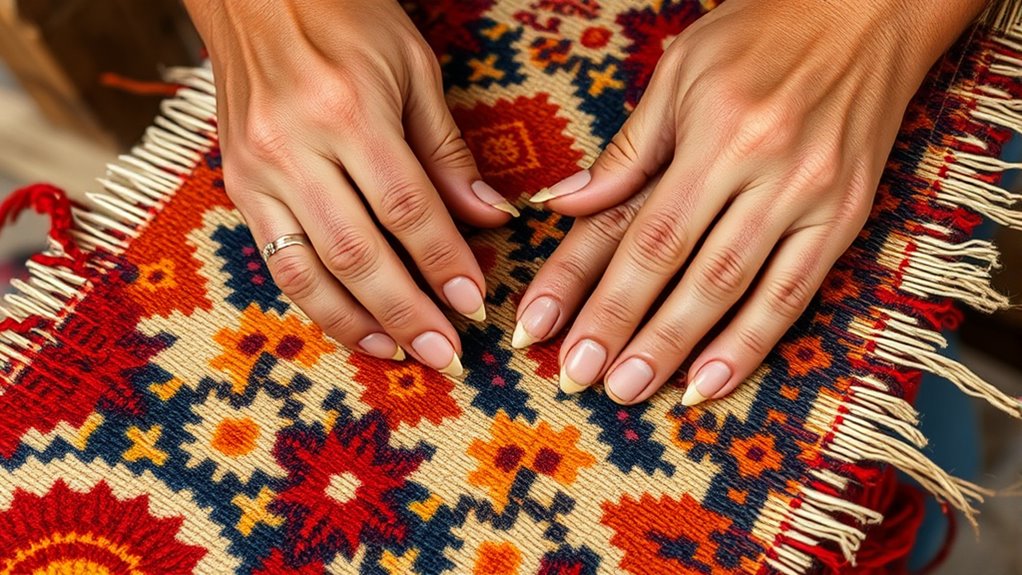
What makes each regional style of Sardinian handicrafts unique lies in their distinctive techniques, motifs, and materials. You’ll notice that:
- Samugheo’s weaving features *pibiones*—raised bumps created by winding threads, with over 4,800 warp threads on a single bedspread, all woven by hand on horizontal looms.
- Nule favors vertical looms, producing textiles with geometric and natural motifs influenced by Native American and Mexican designs, blending traditional and modern methods.
- Aggius showcases motifs inspired by Eastern European patterns, combining natural symbols and heraldic emblems that reflect Sardinian heritage.
- The techniques differ across regions, with materials like cotton, wool, linen, and complex threading, highlighting the craftsmanship and cultural symbolism embedded in each style.
Cultural Significance of Weaving Practices
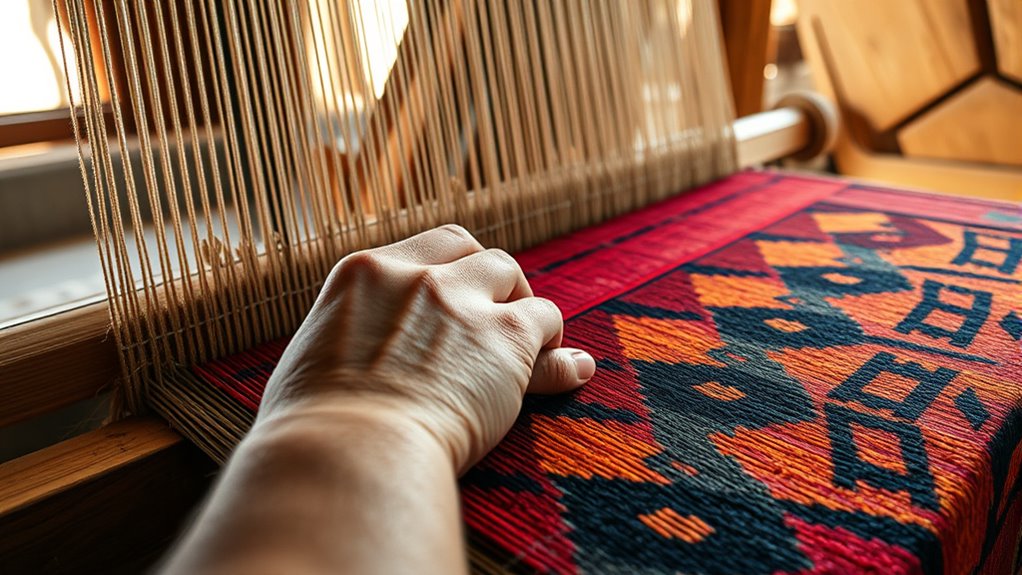
You can see how weaving in Sardinia is more than just craft; it’s woven into cultural rituals and symbols that express identity. Women traditionally hold the key to maintaining these practices, passing down skills and traditions that reinforce community bonds. Today, efforts to preserve this heritage highlight its ongoing importance and the need to keep these meaningful customs alive. Sardinian textiles have been recognized by UNESCO as part of the Intangible Cultural Heritage of Humanity, underscoring their global significance. This recognition helps promote awareness and appreciation for the intricate craftsmanship and cultural history embedded in Sardinian weaving traditions.
Cultural Rituals and Symbols
Here are four key symbols:
- Geometric designs reflecting cultural identity and natural surroundings. These patterns often encode regional stories and beliefs, serving as a visual language of Sardinian heritage.
- *Pibiones* symbolizing fertility and economic prosperity. In addition to their symbolic meaning, these motifs are traditionally woven into textiles used during important communal celebrations.
- Colors mirroring landscape and spiritual elements. Sardinian artisans utilize dyes derived from native plants, ensuring that each piece embodies the island’s unique environment.
- Blessings and gifts received during textile creation for health and protection. Sardinian handweaving is deeply intertwined with local rituals that invoke blessing and safeguard the weaver and community.
Gender Roles and Traditions
In Sardinia, weaving has long been a domain dominated by women, shaping both cultural identity and social roles. Women traditionally inherited skills from mothers, handling tasks like spinning, dyeing, and weaving textiles such as hope chests and clothing. Men focused on pastoral work, leaving textile production to women. Textile patterns often carry gender-specific symbols, offering protection and blessings related to roles like fertility and prosperity. These designs tell stories of the land, mythology, and pastoral life, reinforcing cultural bonds. Weaving also played a ritualistic role in marriage and social rituals, with textiles symbolizing societal status and identity. The table below highlights key aspects of gender roles in Sardinian weaving:
| Aspect | Role |
|---|---|
| Female Handweavers | Textile creation, transmission of traditions |
| Male Contributions | Pastoral, agricultural work |
| Symbolic Patterns | Gender-specific meanings and protection |
| Community Involvement | Intergenerational knowledge transfer |
In addition, the cultural significance of weaving practices is emphasized through traditional ceremonies and celebrations that honor women’s craftsmanship.
Heritage Preservation Efforts
Sardinian weaving is recognized as an essential part of the island’s cultural heritage, with efforts actively underway to preserve and promote this centuries-old tradition. You can see this in initiatives like:
- Workshops and studios that teach traditional techniques to new learners while honoring age-old methods.
- The limited number of professional weavers whose studios serve as crucial centers for preservation and education.
- Public events such as film screenings and discussions that raise awareness of the cultural importance of Sardinian textiles.
- Museums and cultural organizations that archive, display, and promote the craft, connecting local heritage with global audiences.
- The integration of traditional weaving techniques into contemporary design projects helps keep the craft innovative and relevant for future generations.
These efforts ensure that Sardinian weaving remains vibrant, relevant, and appreciated for generations to come.
Symbols and Patterns in Sardinian Textile Art
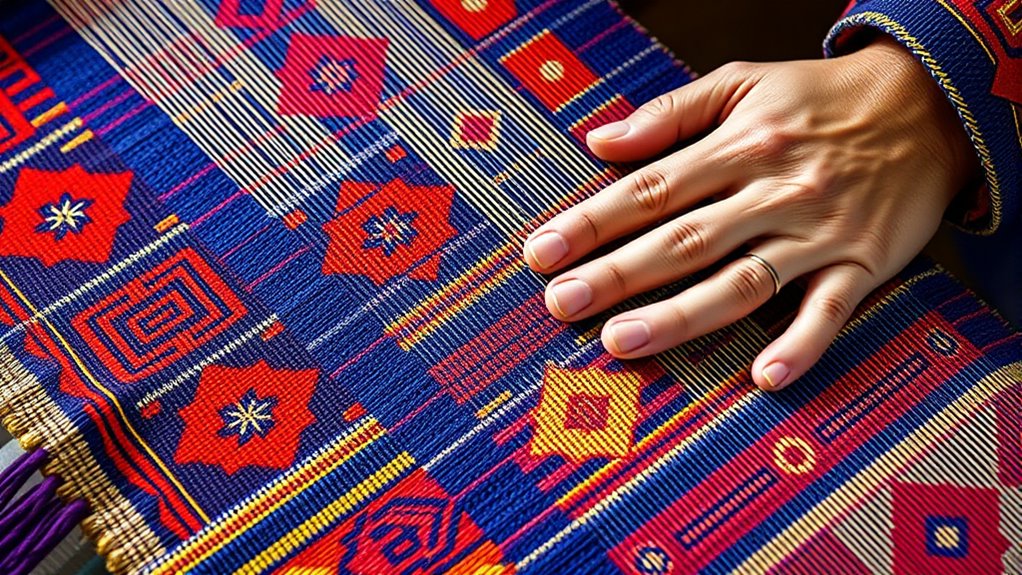
Symbols and patterns in Sardinian textile art reveal a profound connection between the island’s artisans and their environment, history, and spiritual beliefs. You’ll notice that many motifs draw inspiration from nature and geometric shapes, symbolizing natural cycles like birth, growth, and death. Religious, Nuragic, and heraldic symbols link textiles to Sardinia’s ancient past and spiritual identity. Specific motifs, such as birds or agricultural symbols, represent fertility, protection, and abundance. Regional variations, like black-and-white fabrics from Samugheo or peacock borders, reflect local traditions and evolving styles. Techniques like the pibiones add tactile depth, emphasizing meaningful motifs. These symbols aren’t just decorative—they carry stories, beliefs, and social significance, especially in textiles used for important life events, preserving cultural heritage across generations. Weaving the myth – Sardinian textile production Main production was traditionally performed by women, initially as artisanal work and later as entrepreneurial and emancipatory.
The Role of Women in Sustaining Weaving Traditions
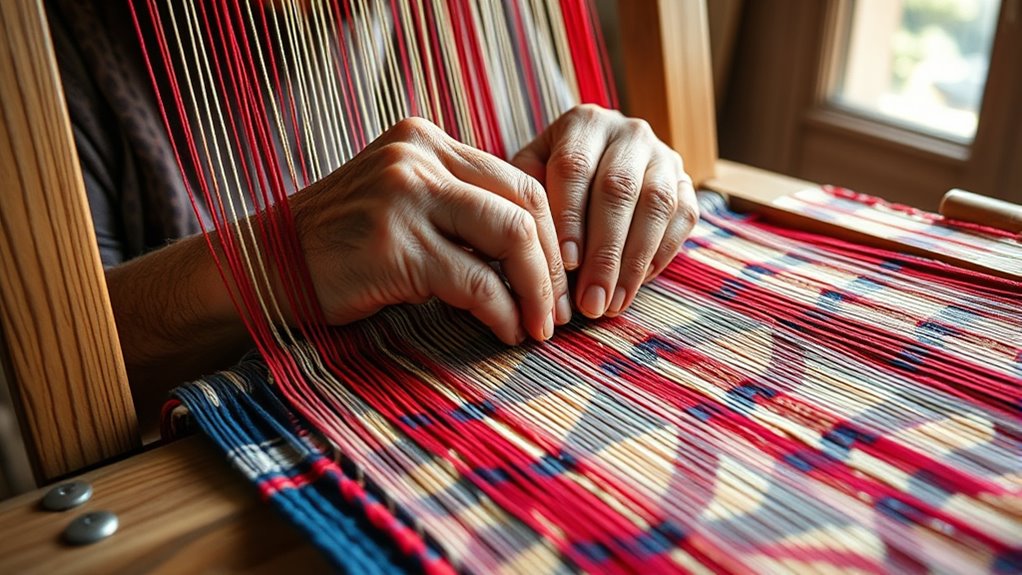
You see, women pass weaving techniques from mother to daughter, keeping the craft alive across generations. This tradition isn’t just about skills but also a way to preserve regional identity and cultural heritage. By continuing these practices, women guarantee Sardinian textile customs stay vibrant and meaningful. Deeply rooted tradition ensures that each generation maintains a connection to their history and cultural identity through this art form. Additionally, the integration of automation in business has influenced the way traditional crafts are preserved and promoted in modern contexts.
Mother-to-Daughter Transmission
The transmission of weaving skills from mother to daughter has been the backbone of Sardinian textile tradition for centuries. This lineage keeps alive unique techniques and secrets, ensuring continuity. As you observe, women pass down knowledge through generations in various ways:
- They teach complex *pibiones* techniques involving detailed hand-counting, preserving multidimensional skills.
- Families maintain household looms, enabling daughters to learn by practicing daily tasks like weaving clothing and textiles.
- Maternal figures pass on understanding of fibers, dyes, and regional motifs (*mustras*), shaping regional styles.
- Knowledge of loom setup, warp preparation, and intricate decorative methods remains within family lines, reinforcing artisanal mastery.
- The preservation of these skills is supported by the fact that traditional weaving remains a vital part of Sardinian cultural identity and community life, helping sustain cultural heritage across generations.
This close kinship transmission sustains not only skills but also cultural identity, embedding weaving deeply into Sardinian women’s social and familial roles.
Cultural Identity Preservation
Women play a crucial role in preserving Sardinian weaving traditions, ensuring that centuries-old techniques and cultural meanings remain alive. Historically, weaving was a skill women were required to master, and they’ve continued to be the primary custodians of this craft. As *tessitrici artigianali*, they uphold traditional methods, passing skills through generations and maintaining cultural significance. Their weaving reflects legends, spiritual beliefs, and social identity, making textiles more than just clothing—they’re symbols of community and perseverance. Women’s work supports local economies and celebrates Sardinian heritage through costumes, dowries, and ceremonial textiles. Despite modern challenges, female artisans keep alive the artistry, blending tradition with innovation. Their dedication safeguards Sardinia’s textile legacy, reinforcing cultural pride and identity for future generations. Emphasizing leadership skills within these communities highlights how women serve as vital leaders in cultural preservation and transmission.
Influences of Nature and Environment on Designs
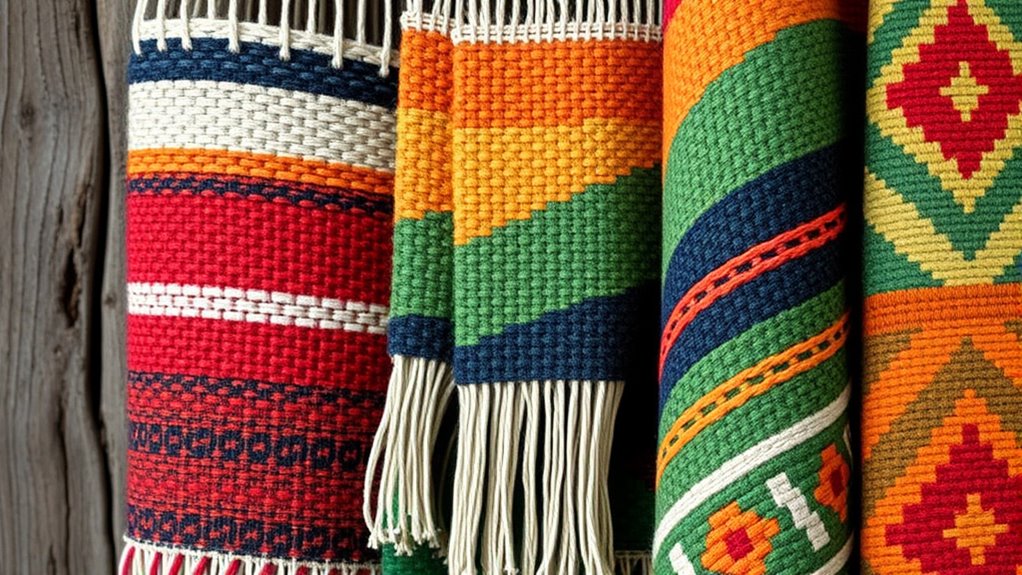
Nature and the environment have profoundly shaped Sardinian textile designs, with motifs directly inspired by the island’s flora, fauna, and landscapes. You’ll notice patterns that reflect local biodiversity, such as plants, animals, and landscapes, often symbolized through geometric and zoomorphic shapes. Here are four ways this influence manifests:
- Textile motifs incorporate representations of native flora and fauna, linking designs to the island’s natural surroundings.
- Colors derive from Sardinian plants, creating earthy hues that mirror the environment.
- Regional weaving techniques adapt to local landscapes, affecting pattern styles and fabric weight.
- Materials like sheep’s wool and plant fibers are chosen based on environmental availability, ensuring textiles harmonize with the landscape.
These elements showcase how Sardinian artisans embed nature’s essence into their craftsmanship.
Revival Efforts and Contemporary Artisanship

Revival efforts have played a crucial role in preserving and promoting Sardinian textile traditions, ensuring that skilled craftsmanship continues to thrive today. The Sardinian Institute for the Organisation of Artisanal Labour (I.S.O.L.A.) led initiatives in the 1960s, offering courses that blended traditional techniques with modern methods. These programs helped transform weaving from a domestic activity into small businesses, especially around Samugheo. Today, workshops and artisan schools keep weaving skills alive, often passed down through families, with women remaining key artisans. Regional communities like Samugheo, Nule, and Aggius maintain distinct styles and techniques, fostering local identity. Modern workshops now teach broader audiences, revitalizing interest and supporting community engagement. These efforts have also integrated weaving into cultural tourism, showcasing Sardinian craftsmanship to a wider world. Contemporary artisanship continues to evolve, blending tradition with innovation to keep Sardinian textile heritage vibrant and relevant.
Sardinian Textiles in Modern Society and Economy
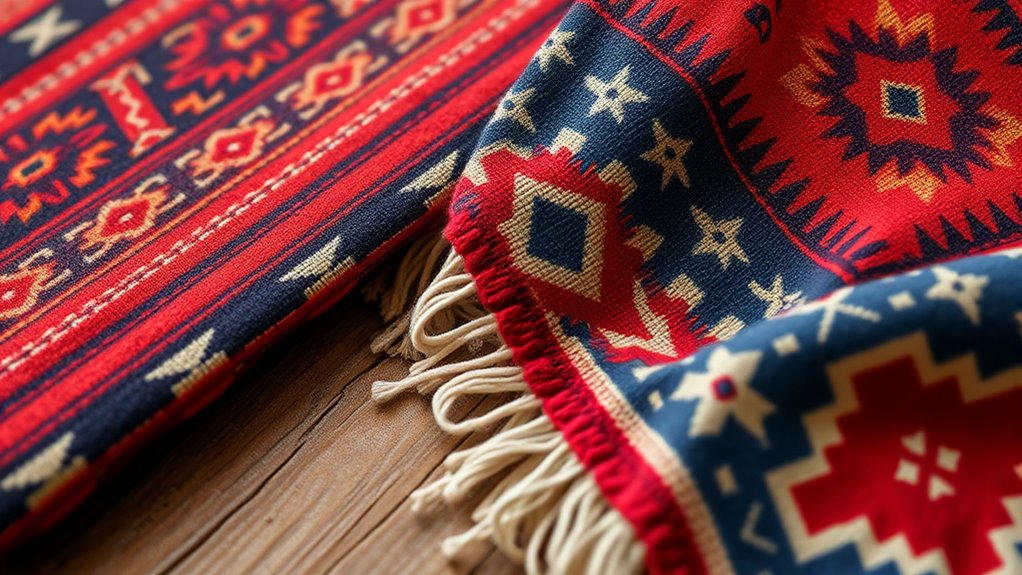
Sardinian textiles occupy a significant role in Italy’s modern economy and cultural landscape, blending traditional craftsmanship with contemporary market demands. You’ll find these textiles contributing to Italy’s USD 25.67 billion industry, mainly through small, family-run businesses. Here’s how they stand out:
- They connect local wool production from Sardinian sheep to a thriving regional economy.
- They serve niche markets that value heritage, craftsmanship, and artistic quality.
- They adapt to modern trends by combining handweaving with advanced technology, like jacquard machines.
- They benefit from Italy’s global reputation in luxury fashion, boosting demand and premium pricing.
- The industry’s growth is driven by increasing consumer interest in sustainable and artisanal products, further supporting Sardinian artisans.
These efforts help sustain artisanal skills, promote sustainable products, and expand into Italy’s growing apparel and technical textile sectors through digital channels.
Frequently Asked Questions
How Do Sardinian Weavers Preserve Ancient Patterns Across Generations?
You preserve ancient patterns by passing down techniques from generation to generation, often through family traditions. Women in Sardinia teach their daughters how to weave intricate designs, like geometrical patterns and the Pibiones technique. Community workshops and cooperatives also play a crucial role, ensuring these skills stay alive. By maintaining these practices, you keep the cultural heritage vibrant, connecting the past with the present through your craftsmanship.
What Are the Modern Uses of Traditional Sardinian Textiles Today?
You might think traditional textiles are just for museums, but nope—today, they’re front and center in fashion and home decor. You’ll see Sardinian weaving in haute couture collections like Dolce & Gabbana, adorned with crystals for a luxe touch. These textiles also brighten up your living space, from intricate bedspreads to modern rugs. So, your old crafts are now making stylish statements, blending heritage with contemporary flair.
How Do Natural Dyes Influence the Colors of Sardinian Woven Textiles?
Natural dyes greatly influence the colors of Sardinian woven textiles by providing rich, authentic hues that reflect local flora and fauna. You’ll notice warm yellows from onion skins and saffron, deep blacks from logwood, and vibrant reds from kermes insects. These dyes enhance the textiles’ regional identity and cultural value, creating unique, enduring colors that stand out. Their natural origins also maintain sustainable traditions, ensuring each piece is both beautiful and meaningful.
Are There Specific Rituals Associated With Sardinian Weaving Practices?
You see, rituals in Sardinian weaving connect tradition to spirituality, community, and identity. You participate in setup rituals, carefully warping the loom, recounting threads if lost, and blessing the fibers for good luck. You honor the weaver’s skill through prayers, offerings, and meticulous work. These rituals mark life events, preserve cultural symbols, and uphold sacred practices, making each woven piece a profound symbol of Sardinian heritage and spiritual protection.
How Has Tourism Impacted the Preservation of Sardinian Textile Crafts?
Tourism has positively impacted Sardinian textile crafts by providing a platform to showcase and promote traditional weaving techniques. You see increased demand from visitors, which encourages artisans to keep their skills alive and invest in their workshops. However, you also face challenges like commercial pressures to produce cheaper, mass-produced imitations that threaten authenticity. Overall, tourism helps preserve cultural identity but requires careful management to maintain craft integrity.
Conclusion
You can see how Sardinian weaving is a vibrant tapestry woven from history, culture, and nature. It’s a living tradition that breathes life into the island’s identity, like a colorful thread connecting past and present. By appreciating these textiles, you help keep this rich heritage alive, ensuring it continues to flourish like a resilient bloom in the garden of craftsmanship. Embrace Sardinian weaving, and become part of its timeless story.
